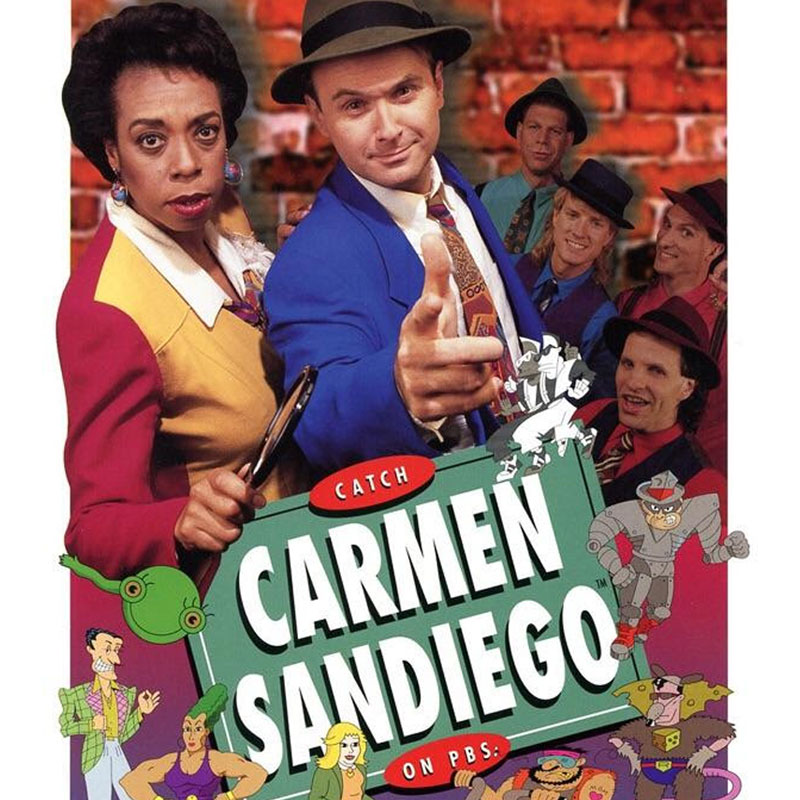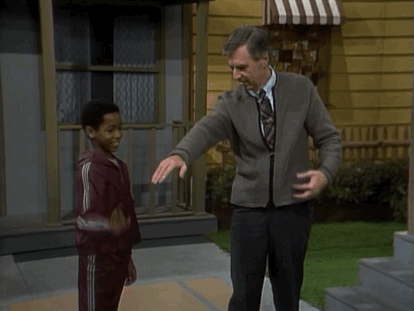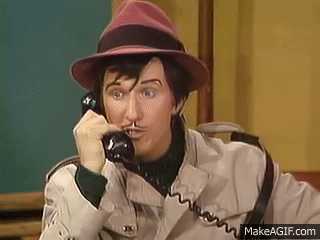
[Carmen Sandiego image courtesy producer Howard Blumenthal]
By Ade D. Adeniji
Sesame Street. Magic School Bus. Mister Rogers’ Neighborhood. Reading Rainbow. Millennials and Gen Xers were lucky enough to come of age during the prime of public educational television. But while many of us might also take this kind of programming for granted today, there was a time when educational broadcasting on both television and radio didn’t have much legs.

In the 1920s, the Federal Radio Commission declared a need for broadcasting to serve the common good. During this time, educational radio stations were created on different college campuses, and, in 1952, the FCC earmarked 242 channels for educational use. That same year, a precursor to PBS called National Educational Television, backed by the Ford Foundation, was born.
There were many other interesting educational projects in these early days. Perhaps the most provocative is the Midwestern Program on Airborne Television Instruction, or MPATI. The nonprofit, launched in 1959 and also supported by Ford Foundation, decked out two DC-6 planes with an arsenal of transmitting equipment weighing six-and-a-half tons, according to early Chicago television historian Steve Jajkowski. These birds then took to the skies broadcasting educational programming to membership schools in Indiana, Illinois, Kentucky, Michigan, Ohio, and Wisconsin.
Eventually, in 1969, PBS emerged and, as it evolved, brought with it a veritable treasure trove of educational programming. If you grew up in the 1970s, the 1980s like me, or the 1990s, odds are many of these programs were part of your childhood. Let’s now take a trip down memory lane with some of the most popular and enduring shows by decade.
1960s/1970s
Mister Rogers’ Neighborhood (1968-2001)
A show that needs no introduction, Mister Rogers’ Neighborhood ran for 31 seasons as an American nation navigated the Civil Rights Era, Vietnam, the Cold War, and plenty more. Mister Rogers is Fred Rogers, a Pittsburgh native, one-time Dartmouth College student, and an ordained Presbyterian minister. The man made the red cardigan sweater look cool, all while influencing children around the world.
Mister Rogers’ Neighborhood spoke to the importance of community and brought together a cast of characters to play Rogers’ neighbors, including Mr. McFeeley, the postman. Another long-running character, Officer Clemmons, who is Black, helped deliver one of the most memorable moments in the entire series. The two friends dipped their feet into a pool of water together, challenging one of America’s most racially contested spaces and delivering a message of tolerance and decency to children.
In addition, the show used puppets to bring alive its fictive Land of Make Believe, jam-packed with lessons for children, including telling time and the importance of exercising.
Fred Rogers passed away at the age of 74 in 2003, and was recently depicted in the fictional film A Beautiful Day in the Neighborhood (2019) starring Tom Hanks, and the documentary Won’t You Be My Neighbor? Fittingly in his native Pittsburgh, the local Jewish Community Center hosted “The Loving Kindness of Fred Rogers,” a photo exhibit that was launched on the heels of the tragic Tree of Life Synagogue antisemitic shooting.
The Electric Company (1971-1977)
Before he was Red in The Shawshank Redemption, Mandela in Invictus, or God Himself, actor Morgan Freeman starred in The Electric Company, a 1970s children’s show where he played a hodgepodge of roles including Easy Reader, and, as seen below, Mel Mounds, a smooth-talking DJ who uses wordplay to teach language skills and vocabulary.
The show was produced by Children’s Television Workshop, the brainchild of Joan Ganz Cooney and Lloyd N. Morrisett Jr., an American experimental psychologist. You might know one of the other shows the duo produced called Sesame Street. (A surprising bit of trivia: It was produced and written by character actor Paul Dooley—noted for his work in Sixteen Candles, Breaking Away, The Practice and so much more.) The Electric Company’s audience, though, targeted elementary school students too old for Sesame Street but still in need of vital literacy tools.
Tapping psychedelic graphics, fun animation, mod outfits, larger-than-life characters, and sketch comedy, The Electric Company used a range of assets to teach kids how to read and be confident in it. Take this cool silhouette feature that helped kids sound out words.
https://www.youtube.com/watch?v=Sf3RtR1n_SM
And we’ll never forget Fargo North, Decoder, a private eye who would solve missing-letter mysteries.

Though not unusual today, in the early 1970s, producer Samuel Gibbon and a team of writers and producers, reading experts, and other academic advisers spent a year-and-a-half doing research and developing the show before it hit the screens. All this hard work paid off. The show won two Emmys, aired on more than 250 public TV stations and became a teaching tool in thousands of classrooms nationwide.
READ MORE
Comfort Viewing During the Pandemic >>
Forgotten Sleeper
Rebop (1976-1979)
Another Samuel Gibbon project, Rebop was an American children’s television series that aired on PBS stations and was produced by WGBH Boston from 1976 to 1979. Segments filmed across the U.S. explored the activities of culturally diverse young people in this program aimed at 9- to 13-year-olds. One 1977 episode takes us inside Ebony Impromptu Theater Company as seen through the eyes of young teenage dancer Adam Lee.
Their rehearsals are held in an old firehouse in the Washington D.C. area and involve music, dance, and spoken word poetry. The theme song was arranged by the great Quincy Jones. And before LeVar Burton went on to star in Reading Rainbow, he was a host on Rebop.
READ MORE
Road Trippin’: Documentaries for All 50 States >>
Public Service Announcements: A Look Back >>
1980s
Reading Rainbow (1983-2004)
German-born LeVar Burton has the distinction of being on not one, but two legendary shows. And he was nearly the host of Jeopardy! too. After playing Kunta Kinte on the adaptation of Alex Haley’s slavery masterwork Roots, Burton arrived at PBS to host Reading Rainbow, which ran for more than two decades and racked up 26 Emmys.
Of course, there’s the classic Reading Rainbow theme song, which is both simple and yet also layered:
I can be anything
Take a look
It’s in a book
A Reading Rainbow
A Reading Rainbow
The show also wasn’t static, with LeVar Burton just sitting on a stool reading. He actually got out into the real world to bring these stories alive. In the episode “The Day Jimmy’s Boa Ate the Wash,” Burton starts out at a pet shop that specializes in rare out-of-the-ordinary pets. And later, the show visits a state fair to investigate livestock competitions. And that was just one ordinary day on Reading Rainbow.
https://www.youtube.com/watch?v=Dr6kcn4HRG8
A new documentary in production, Butterfly in the Sky, will include archival footage as well as new interviews with Burton and others involved with and inspired by the pioneering television show.
Reading Rainbow Remix from PBS Digital Studios:
Shining Time Station (1989-1995)
Shining Time Station was a quirky and instructive live-action program that took place inside a train station presided over by Mr. Conductor, (first played by former Beatle Ringo Starr, followed by George Carlin, and then others) who is joined by “Flexitoon” puppet characters and a rotating cast, including Indigenous actor Tom Jackson as Billy Twofeathers. The program actually has British roots and was spun out of an earlier show called Thomas the Tank Engine & Friends. But Shining Time Station is the show that brought that iconic Thomas character to audiences around the world.
Here’s some additional lore about the show. Some of the earliest characters from Thomas the Tank Engine & Friends were born all the way back in the 1940s. In those days, Reverend W. Awdry, an Anglican clerk, told stories to his sick son about special steam trains. But his son, ever the stickler, would correct Awdry when the stories weren’t told the exact same way. So Awdry took to writing them down, publishing in 1945 The Three Railway Engines, the first of nearly 30 books in The Railway Series.
Created by Britt Allcroft and Rick Siggelkow, Shining Time Station made its television debut on Sunday, January 29, 1989, on the PBS network affiliate WNET and ran until 1993, along with a series of 1995 specials.
Forgotten Sleeper
3-2-1 Contact (1980-1988)
3-2-1 Contact was an underrated science program for 8- to 12-year-olds that aired for most of the 1980s. The show tapped Dr. Edward G. Atkins to create much of the scientific content with the goal of not replacing the classroom but generating interest in science which could then translate to science class. Actors like Rita Moreno and a young Sarah Jessica Parker appeared in the first season, before the format changed to be more realistic.
A 1980 episode introduces a voice computer from pioneering Bell Labs, as well as other sound devices.
By 1984, the show reported over 7 million viewers. Uniquely, kids themselves hosted the show. Locations ranged from a New Jersey junkyard to a stroll along the rim of an active volcano. ”We were within about 50 feet of the lava vents, and the soles of my shoes were melting,” Judy Leak, a teenage actress on the show, once told The New York Times.
1990s
Where in the World Is Carmen Sandiego? (1991-1996)
One of my personal favorites, this ’90s show for ’90s kids was based on a popular computer game series. Your mission for this unique gameshow: Hunt down the internationally-renowned criminal Carmen Sandiego by solving geography puzzles. The show featured Lynne Thigpen as the Chief of the ACME crime-solving unit.

Then there’s Rockapella, a zany acapella group that provided live music during the show, including its legendary theme song. The Where in the World is Carmen Sandiego soundtrack on cassette and CD, meanwhile, features Rockapella and other artists who continued to build out the Carmen Sandiego values of geography, adventure, and discovery. One Rockapella song, “Capital,” might be the best mnemonic for learning all the U.S. capitals ever conjured. Tito Puente and Nestor Sanchez’s Latin jazz composition “Amazing World,” is another highlight.
The soundtrack also features satirical radio call-ins, including one from Gary Drews, then-mayor of Pierre, South Dakota, who gets on the line to set the record straight about his beloved city:
“…It’s pronounced ‘pier,’ not ‘Pierre.’ I vehemently object to the callous omission of our fair city from the main body of the song entitled ‘Capital.’ Pierre has much to offer, Flaming Fountain for example, which is fed by an artesian well with a natural gas content so high that it can be lit!”
Magic School Bus (1994-1997)
Everyone has teachers they vividly remember from childhood. But then there’s Ms. Frizzle, teacher to us all. Starring the voice of Lily Tomlin, Magic School Bus had a four-season run on PBS during the mid-1990s. Ms. Frizzle leads her class of students through wild adventures that bring their weekly science lessons to life.
How exactly? Well, that’s where the Magic School Bus comes in, taking these kids on field trips out of this world. “The Busasaurus” episode sees Frizzle and her class time travel to the late Cretaceous Period after visiting a paleontologist. This one came out in 1995, two years after a certain Spielberg classic about the dinos.
Another episode, “Inside Ralphie,” takes us inside the body of a sick-at-home student, teaching us about the immune system and the different virus-fighting components in our arsenal. If only we could get the entire world on that bus today.
Ms. Frizzle, wherever you are now, we need you.
Forgotten Sleeper
Wishbone (1995-1997)
In the pantheon of fictional dogs from film and television, loyal Lassie, fearsome Cujo, or even Brian from Family Guy loom large. But the half-hour live-action children’s television show Wishbone, starring the Jack Russell Terrier by the same name, had a few good years of popularity.
Texas writer-director Rick Duffield was working at Lyrick Studios, the company behind Barney & Friends in 1992, when he pitched a children’s series starring a dog. At the time, Duffield only had experience with playwriting and learned the process of screenwriting on the go.
The show featured teenage boy Joe Talbot, his mother Ellen, and their dog Wishbone, along with other friends and neighbors in their small town. Focused on storytelling and literature, Wishbone retold tales from Oliver Twist to Frankenstein.
Wishbone producer Betty Buckley recalls a trip to Hollywood where producers met dogs from the popular films of the day, including Look Who’s Talking Now, but ultimately settled on that special Jack Russell pup because of his ability to do backflips and jump. Unlike Brian Griffin, Wishbone does not talk. Instead, we hear his thoughts.
The show also inspired several book series all published under Big Red Chair Books, the moniker of Lyrick Studios. There was even talk of a big screen movie adaptation, though I’m not sure where that stands today.
2000s
As the millennial generation rode the wave of the world wide web, PBS educational programming has continued into the 21st century. In 1999, PBS launched the PBS Kids brand on several fronts, including a home video label, and expanded into many apps that supplement and augment learning. And on the television front, new shows continue to captivate audiences, emphasizing those same literary skills, love of science, and diversity.
Between the Lions, a series that ran for 10 seasons from 2000 to 2010, focuses on a very unique library run by lions Theo, Cleo, Lionel, and Leona.
The show was known for its variety of literary-focused segments, including loveable Chicken Jane, and Gawain’s Word, with a Wayne’s World-esque intro and featuring a medieval knight who sounds more like surfer dudes Bill and Ted, which took viewers on an excellent adventure in phonetics.

Cyberchase, meanwhile, focuses on the hijinks of three kids from Earth who find themselves in a digital universe—promoting math, environmental science, and wellness skills. After a hiatus, Cyberchase will premiere its thirteenth season in 2022.
Another more recent hit, from the 2000s, the cartoon Maya & Miguel centers on the lives of Latinx first-generation siblings.
We’ve come a long way since those early days of beaming educational programming from the skies. Now, these old PBS shows and games can be played from your iPad in the skies at 36,000 feet. Here’s to hoping all children can continue to enjoy the best of these programs in the coming years.
Ade Adeniji is a Staff Writer for Inside Philanthropy and an approved Rotten Tomatoes critic. He’s also written for outlets CBS News, WIRED, Newsweek, Mic, and The Rumpus, and blogs about film, television, and the majestic NBA on his own website, adeadeniji.com.
